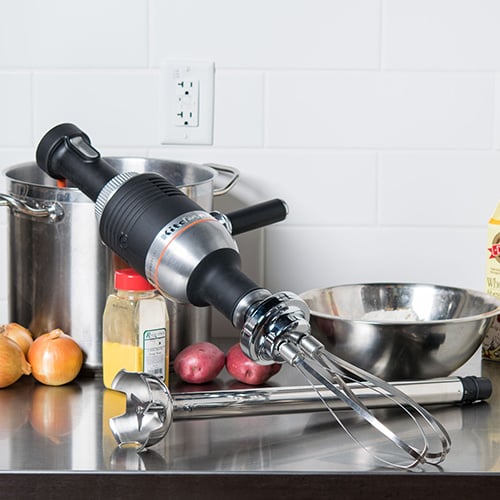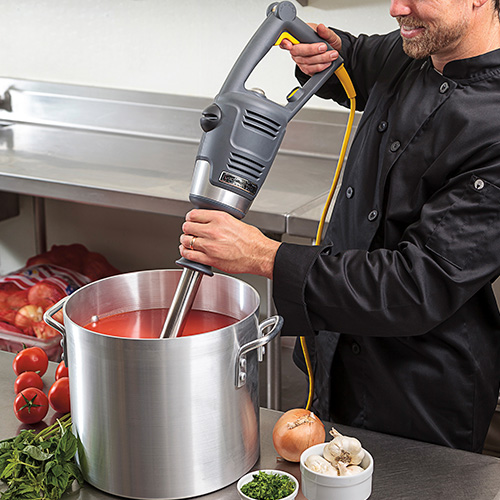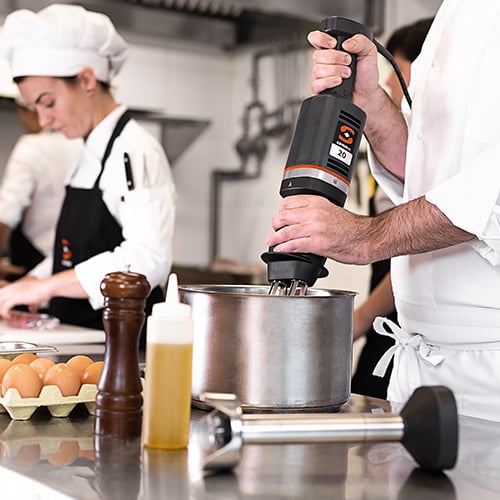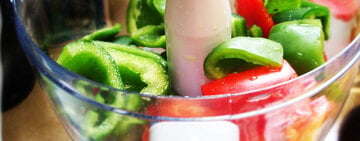What Is an Immersion Blender?
An immersion blender is a versatile handheld blender that serves multiple purposes in the kitchen. Also referred to as a hand blender, an immersion blender allows you to prepare ingredients in ways that a traditional blender wouldn't. Immersion blenders comprise two main parts: an electric motor and a blending arm. In this blog, we’ll investigate what an immersion blender is, what to use one for, and how to operate one correctly.
Shop All Commercial Immersion Blenders
Immersion Blender Video
Use the video below to learn how to use an immersion blender.
What Is an Immersion Blender Used For?

Immersion blenders are used to complete many of the same tasks as countertop blenders. Their convenient handheld design gives you the benefit of flexibility in the kitchen. Immersion blender applications include:
- Blending
- Pureeing
- Emulsifying
- Whipping
- Chopping
Immersion Blender Attachments
Several immersion blender accessories can help you achieve the desired results in your food. Some of the most popular attachments are as follows:
- Chopping blade: As its name suggests, a chopping blade allows you to use your immersion blender to chop fruits, vegetables, and other similar foods.
- Frother: An immersion blender frother aerates drinks such as milk, which can be helpful when preparing foam for coffee.
- Whisk: A whisk attachment prepares batters and sauces. It allows you to whisk ingredients more effectively than you would by hand.
- Wire beater: The wire beater attachment is helpful when preparing baked goods. In particular, they can be used for heavier foods such as frosting and cookie dough.
How to Use an Immersion Blender

An immersion blender submerges, or immerses, its blade into a pot of ingredients to combine them. However, there are several factors to consider if you want the best results. Below, we’ve compiled a list of steps to guide you through the process of using an immersion blender.
- Assemble your blender: Begin by assembling your immersion blender as directed by the manufacturer. If you plan on using attachments or accessories during the blending process, attach them during this step.
- Connect to power: Verify that your immersion blender is plugged in. If possible, choose an outlet separated from your cooking space to protect against accidental severing or disconnection of the cord.
- Insert the blender: Submerge the blending attachment directly into your mixture. To avoid splashing, verify that any blades or accessories are completely submerged.
- Begin blending: Activate your immersion blender and begin the blending process. For consistency, slowly move the device up and down in the mixture.
- Take breaks: In some cases, running an immersion blender for an extended period can damage the device. To reduce this risk, only blend for 30-50 second intervals.
- Disconnect from power: To maintain kitchen safety, unplug your immersion blender as soon as you are finished to ensure it will not turn on once removed.
- Clean the blender: After cooking, properly clean and sanitize your immersion blender.
Immersion Blender Substitute
It is still possible to achieve similar results to an immersion blender if you don't own one for your kitchen. Because of an immersion blender’s versatility, several kitchen appliances can be used as a substitute. Below, we’ll investigate common immersion blender alternatives and what differentiates them.
Blender vs Immersion Blender
The difference between a blender and an immersion blender is design. Blenders are countertop appliances that feature a blending jar, while immersion blenders are used by hand. Despite this, countertop blenders are still the most common substitute for immersion blenders and typically produce the best results. One key drawback to using a countertop blender is that you’ll have to pour or scoop the mixture out after use.
Immersion Blender vs Hand Mixer
The main difference between an immersion blender and a hand mixer is power. Hand mixers are best used for lighter tasks, such as preparing batter. Conversely, immersion blenders offer more power, making them ideal for heavier mixtures. Though their range is limited, a hand mixer can be used as a substitute for an immersion blender in select recipes.
Food Processor vs Immersion Blender
The details that set a food processor and an immersion blender apart are their design and blades. Like a traditional blender, a food processor is a countertop appliance. It features unique flat blades designed to chop and process dry foods. Food processors can be used for liquid ingredients, but won't be as effective. Conversely, an immersion blender works well with both solid and liquid ingredients. If you’re looking to prepare certain foods in a pinch, a food processor is an efficient but limited replacement.
Immersion Blender FAQ
Below, we’ll answer some of the most commonly asked questions about immersion blenders.
What Is Immersion?
In cooking, immersion is defined as the act of dipping or submerging something in a liquid.
How to Keep an Immersion Blender from Splattering?

One disadvantage of immersion blenders is that they can splatter ingredients across the kitchen. This can cause unnecessary messes and even pose a threat to food safety. Below, we've provided three tips to help reduce the risk of your immersion blender splattering:
- Keep the blade submerged: Keep your immersion blender’s blade completely submerged during use. A blade or blending attachment that is partially submerged is likely to create splatter.
- Use a high-sided container: Choose a pot or container with high sides before blending. A container that is too low may not offer enough protection.
- Begin on the lowest setting: If your immersion blender offers different speed settings, begin blending using the lowest option. Starting too high can limit your control over the blender, leading to splattering.
How to Use an Immersion Blender Without Scratching?
If it isn't handled with care, an immersion blender can leave scratches on the surface of your containers, bowls, or pots. Adhere to the tips below to avoid unnecessary damage:
- Choose the right bowl: When mixing food with an immersion blender, it’s essential to use a bowl or pot that is the right size. Using a bowl that is too small may not fit your blender while using a pot that is too large leaves the surface area exposed.
- Handle with care: Be sure to maintain control over your immersion blender during use. Simply placing the device into a mixture and letting it run can lead to scratching if the operator isn’t careful.
- Maintain separation: While blending, keep the blades elevated slightly above the surface of the bowl. If they get too close, they may scratch the surface.
An immersion blender is a convenient tool that lends itself to many uses in the kitchen. Despite their simple design, their effectiveness can be influenced by several factors. By adhering to the information above, you’ll be able to ensure optimum results from your immersion blender.








